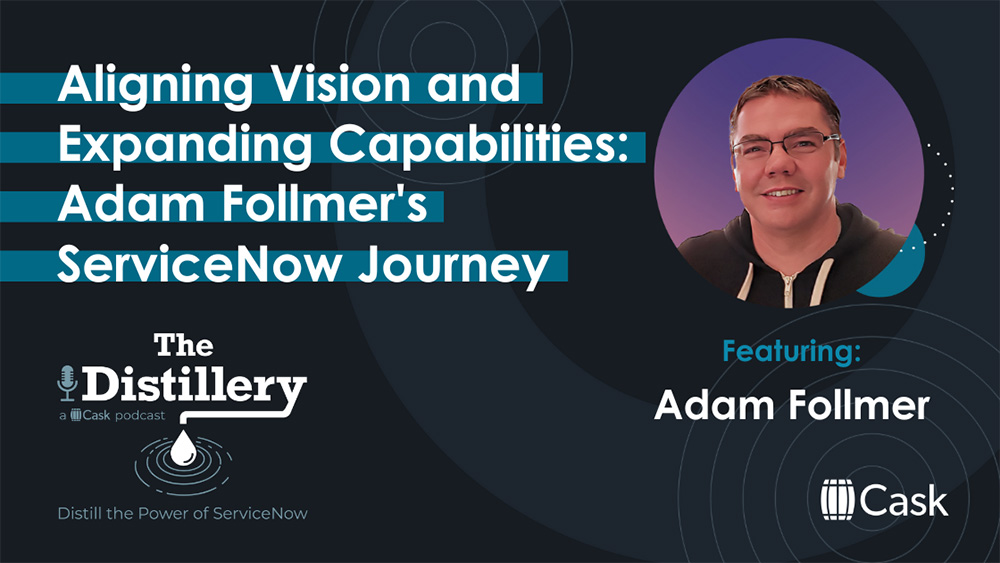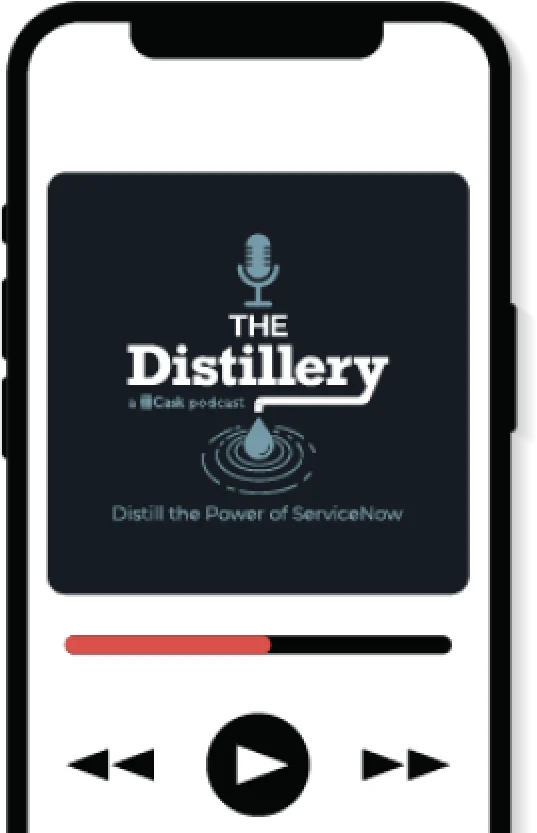El anfitrión:
Sean Dawson
Nuestro invitado:
Adam Follmer

Acompaña a Sean Dawson mientras se sienta con Adam Follmer, un experimentado propietario de plataforma en un bufete de abogados global de tamaño medio. En este episodio, Adam profundiza en su viaje único de implementación de ServiceNow, comenzando con CRM antes de pasar a ITSM. Descubra los retos y triunfos de su agresivo despliegue de seis meses de ITSM, la importancia de la alineación descendente y su transición de metodologías de cascada a ágiles. Descubra cómo gestionan el cambio continuo, crean una cultura de compromiso y preparan el terreno para futuras innovaciones con App Engine y GRC. Este episodio está lleno de ideas para cualquier persona que navega ServiceNow en un entorno organizativo complejo.
Sean: Hola y bienvenidos al Podcast de Cask Distillery una vez más, donde liberamos todo el potencial de ServiceNow con ideas de expertos y estrategias prácticas, sólo aquí en el Podcast de Cask Distillery.
Y conmigo hoy tengo un invitado muy especial: Adam Follmer. Y él es propietario de una plataforma en una gran empresa.
Muchas gracias, Adam, por venir y dedicarnos tu tiempo hoy. Estamos grabando esto un lunes. Realmente lo aprecio: venir del fin de semana. Muchas gracias. Me encantaría que te presentaras y nos contaras un poco sobre la organización para la que trabajas, sólo para enmarcar quién eres y dónde estás.
Adam: Buenos días, Sean, por cierto. Feliz lunes.
Soy Adam Follmer. Soy el propietario de la plataforma de un bufete de abogados de nivel medio o mediano. Somos una firma global. Tenemos 19 oficinas en todo el mundo. Llevo 18 años en el bufete. He hecho de todo, desde soporte general de TI hasta ser ahora el responsable de la plataforma para ServiceNow.
Sean: ¿Cuánto tiempo lleva la organización con ServiceNow y cómo fue la implantación inicial?
Adam: Llevamos cuatro o cinco años con la plataforma. Tomamos un camino un poco diferente: primero lanzamos CSM y luego TI. Así que fue una ruta un poco diferente a la que la mayoría de las empresas convencionales toman para lanzar ServiceNow.
Sean: ¿Cómo fue en realidad el paso a ITSM? Y sé que hiciste CSM. Supongo que esa también sería una buena pregunta. ¿Cuál fue el caso de negocio para CSM al principio y luego ITSM? Porque es típico que primero se haga ITSM y luego se empiece a ampliar. ¿Qué tenía CSM que realmente lo impulsó?
Adam: Hay un par de cosas que realmente están sucediendo allí. La organización tenía un sistema de tickets diferente en el que habíamos empezado a trabajar antes de tener ServiceNow. Así que, durante casi un año, creamos un par de grupos CSM en el otro sistema de tickets. Al final, no funcionó y acabamos cambiándonos a ServiceNow.
Nos resultó más fácil empezar con CSM porque ya habíamos realizado todos los ejercicios necesarios para incorporar un equipo a la plataforma. Ya habíamos hecho todos los requisitos. Sabíamos lo que querían. Así que fue muy fácil incorporar a ese grupo. Y el departamento de TI aún vivía en nuestra "antigua mayor". Así que tenía más sentido traer a ese grupo por el trabajo que ya habíamos hecho en ese equipo.
Sean: Sí, tiene sentido. Hablando de toda la plataforma, ¿cómo es ServiceNow hoy -o el programa hoy- en su organización?
Adam: Somos una empresa completa. Obviamente, tenemos CSM. Tenemos ITSM. Hace poco lanzamos un proceso en torno a la gestión de incidentes graves. Fue algo muy emocionante para el departamento de TI. Tenemos ITOM. Tenemos ITAM, incluido SAM Pro. Tenemos gestión de la demanda. Tenemos muchas cosas en marcha en muchos departamentos diferentes. Y luego, en nuestro departamento de CSM, probablemente tenemos siete u ocho grupos diferentes que están aprovechando ese módulo en la actualidad. Así que hay mucha gente: más de 500 usuarios (o cumplidores, dirá).
Sean: Tienes bastantes grupos ahí. Ahora bien, si analizamos todo el programa (CSM, ITSM, MIM (gestión de incidentes graves), ITOM, SAM P), parece que en los últimos dos años ha habido muchos cambios y adaptaciones en ese equipo. ¿Cuáles son algunos de los factores que les han ayudado a empezar a ver más éxito con una plataforma cuando se está lidiando con todo ese cambio?
Adam: Voy a retroceder un poco en la historia porque esto ayudará a pintar el cuadro. Creo que había una pregunta inicial sobre ITSM y cómo era. En ese momento - retrocedamos cuatro años - teníamos un equipo de tres personas: yo, un arquitecto y un desarrollador. No teníamos BA. No teníamos administradores. Pusimos en marcha ITSM en seis meses. Era un calendario muy agresivo, y sacamos ITSM casi de la caja.
Solo eso ya suponía un reto. También lo fue poner en marcha nuestro proceso empresarial. ¿A quién pertenecía? Había problemas de propiedad. Los elementos de catálogo que estábamos trayendo a la plataforma eran elementos de catálogo muy básicos. Y muy poca iteración. La gente no estaba realmente dispuesta a ver un panorama más amplio. Lo que eso significaba era que estábamos haciendo estos lanzamientos en cascada muy grandes, estábamos tratando de alcanzar la perfección, y realmente no tomar las cosas en pequeños bocados.
Adelantémonos dos años a la pregunta sobre los dos últimos años. Lo que hemos cambiado: Hemos conseguido una alineación descendente en toda la organización. Para tener éxito es fundamental que todas las partes interesadas y todos los grupos marchen en la misma dirección hacia el mismo objetivo. Hemos aumentado nuestro personal, sorprendentemente. Sorpresa, sorpresa. Ahora tengo cinco miembros en mi equipo. Tenemos tres desarrolladores, analistas de negocio y administradores. Y luego contratamos a Cask. Así que tenemos un gran contingente de trabajadores contratados que nos están ayudando a trabajar a través de algunos de estos flujos de trabajo primarios para la organización.
Otro factor es que parte del resultado de trabajar con Cask es que hemos establecido mejor las prioridades. Celebramos sesiones de planificación trimestrales y todo el mundo está al tanto de lo que se va a hacer. Y los plazos están definidos. Y tenemos una mejor perspectiva del trabajo que tenemos por delante.
Y otro componente clave de los dos últimos años es que hemos empezado a trabajar de forma ágil. Estamos tomando iteraciones más pequeñas de trabajo. No nos aferramos a una mejora durante meses para intentar perfeccionarla. Tomamos pequeños trozos, los dividimos e iteramos a lo largo del proceso. Y eso nos ha ayudado enormemente no solo a sentir que estamos cumpliendo nuestros propios objetivos y tratando de hacer el trabajo, sino también a ser capaces de lanzar cosas a la organización y luego mejorarlas de manera oportuna.
Sean: Estupendo. Quiero profundizar un poco porque esto es como una madriguera de conejo. Usted ha mencionado ir de la cascada o el tipo de liberación tradicional calendario o gestión de proyectos. ¿Fue difícil o fue un reto para conseguir la organización para pasar de ese tipo de un modo ágil?
Adam: Yo diría que no. Y lo digo porque parte de este crecimiento de la organización consistió en sentarnos a la mesa y descubrir qué era importante para nosotros. Al principio de nuestras sesiones de planificación, enumerábamos todas las cosas que teníamos que hacer. "Tenemos que hacer CMDB" y "Tenemos que hacer más difícil la gestión de activos".
Y también una de esas privatizaciones fue Agile. Recuerdo que en una de nuestras reuniones, el-no sé si los llamaría el comité de dirección, pero nuestro liderazgo se centró en trabajar en CMDB primero. Durante esa reunión, en realidad hablé y dije: "Si queremos que las cosas sean mejores, debemos centrarnos en Agile primero".
En aquel momento, utilizábamos un módulo de mejora continua para realizar todas nuestras mejoras, que no se prestaba realmente a trabajar en trozos más pequeños. Teníamos grandes historias y tardábamos meses en completarlas. Y no se desglosaba. Era esta gran cosa. Y cada historia era una gran cosa. Cuando hicimos el cambio a Agile, inmediatamente vimos mejoras en nuestros ciclos de desarrollo. Casi nos pareció fácil. Fue algo natural, aunque ningún miembro de mi equipo había trabajado antes con Agile. Adoptar ese marco nos ayudó a acelerar, seguir, priorizar y dividir las cosas en partes más pequeñas.
Con el tiempo, el departamento de TI en su conjunto adoptó Agile o sus formas de realizar el seguimiento de su trabajo y de sus proyectos. Fuimos los primeros en introducir Agile en ServiceNow. Y ahora casi todos los grupos de TI del departamento utilizan Agile para mejorar su forma de trabajar. De hecho, tenemos un equipo de "forma de trabajar" que acompaña a ese grupo a lo largo del proceso.
Sean: Gracias por ampliarlo. Es fantástico.
Antes has mencionado algo que me ha tocado la fibra sensible, sinceramente, cuando hablabas del hecho de que había gente que no conocía los procesos -o la organización no conocía los procesos- a la hora de implantar ciertas cosas. Y me parece que muchas personas suelen pensar que pueden encender las cosas y simplemente ir con ella.
Lo llamamos "tecnología de proceso de personas". Sé que lo has oído porque trabajas con nosotros, pero es muy importante porque no se encienden cosas así sin más. Tienes que pensar en ello un poco más. No se trata de hacer clic y ya está. Pero me encanta esa parte de la historia.
Quería hablar de la visión, porque tienes muchas cosas aquí. Tengo curiosidad. ¿Cómo has hecho para definir y compartir tu visión dentro de la organización a medida que introduces estas nuevas ideas y nuevos productos? ¿Qué aspecto tiene para ti?
Adam: Estamos aceptando lo que la organización nos da, en el sentido de que dejamos que la organización defina un poco la visión. Lo que quiero decir es que los distintos grupos tienen prioridades diferentes. Y nosotros incorporamos esas prioridades a la misión, por así decirlo. Lo que voy a decir es que, volviendo a lo que he comentado, lo importante es participar y comprometerse con la organización para poder dirigir tu visión, al mismo tiempo que intentas que la organización consiga lo que quiere.
De ahí surgió la discusión sobre Agile. Queríamos cambiar la forma en que desarrollamos. Teníamos que cambiar la forma en que desarrollamos. Así que parte de nuestra visión era encontrar una manera de mejorar eso. Al trabajar con la organización y sentarse y discutir por qué era importante, entonces fuimos capaces de llevar eso a la visión de la organización.
Es un toma y daca. Pero estar en la mesa y tener confianza para poder hablar y saber hacia dónde quieres ir, pero también saber hacia dónde quiere ir la organización, es muy importante.
Sean: Estupendo. Háblenos un poco del ritmo del cambio y de cómo influye la cultura desde su punto de vista.
Adam: Ahora mismo tenemos en marcha cuatro o cinco líneas de trabajo principales. Vamos muy rápido. Los cambios en la plataforma son mensuales, a veces quincenales. Estamos haciendo grandes lanzamientos todo el tiempo. El cambio es duro. El cambio es duro. Sé que todo el mundo lo ha dicho. Y es cierto. Hasta ahora, la organización, la cultura -de nuevo, con una alineación descendente- ha estado abierta al cambio.
Hace cuatro años, la gente veía ServiceNow como algo que iba a cambiar tu trabajo, o simplemente era algo desconocido para ellos, y no sabían hacia dónde íbamos. Pero hoy en día, todavía hay baches en el camino. Pero la importancia de la gestión del cambio organizativo y de contar con equipos comprometidos con el ritmo del cambio suaviza el golpe, por así decirlo, o hace que el cambio sea más fácil. La gente sabe que estamos cambiando rápidamente. Y hasta ahora, están abiertos a ello.
Sean: Eso es estupendo. Así que has dado en el clavo con algo genial de la gestión del cambio organizativo: pensar siempre en cómo va a impactar/a quién va a impactar, y sacar eso antes para ayudar a aliviar las dudas, aliviar los miedos, y llegar al cambio más rápido. Me encanta.
¿Qué aspecto tiene la gobernanza de la plataforma para su organización ahora, hoy, con todas las cosas que están pasando allí? ¿Qué aspecto tiene?
Adam: La gobernanza de las plataformas es y será siempre un trabajo en curso. Hoy en día, esa es definitivamente, probablemente un área de debilidad para nosotros. Y eso puede atribuirse al ritmo/la eliminación. Algunas de esas cosas no son siempre las más bonitas para trabajar, pero son increíblemente importantes. Ciertamente tenemos un conjunto de normas que utilizamos para nuestro desarrollo, ¿verdad?
Pero lo que sí diré es que será un área en la que nos centraremos a medida que intentemos expandirnos más allá de nuestro equipo de desarrollo. Lo que realmente significa es que uno de los objetivos que nos planteamos este año es intentar crear un programa de desarrolladores ciudadanos y utilizar App Engine. Pero para ello hay que contar con algún tipo de gobernanza. Así que no estamos simplemente entregando las llaves del castillo y permitiendo un caos controlado.
La gobernanza de la plataforma es algo en lo que sin duda vamos a centrarnos más en lo que queda de año para poder permitirnos abrir capacidades para otros en la plataforma.
Sean: Estupendo.
¿Y ahora qué? ¿Qué es lo siguiente para Adam, su organización y ServiceNow? ¿Cuál es la próxima gran cosa o idea?
Adam: ¿Qué no es lo siguiente? Esa es la verdadera pregunta. ¿Qué es lo siguiente? En los próximos seis meses, creo que nos centraremos en crear un portal, incorporar más departamentos, estudiar la vinculación de procesos, empezar a crear ese programa de desarrolladores ciudadanos y aprender sobre App Engine. Y también estamos estudiando el riesgo de gobernanza y el cumplimiento. Esas son algunas de las cosas importantes.
Lo que ocurra después no lo sabe nadie. Sé que tenemos esta lista de lavandería que llamamos la "lista más más". Contiene casi todo lo relacionado con ServiceNow. Estamos muy ilusionados con lo que nos deparará el futuro y las nuevas tecnologías que podremos desarrollar en forma de web.
Sean: ¿Cuál es la mayor lección que ha aprendido en su viaje por ServiceNow?
Adam: No es un juego de palabras, pero es un maratón, no un sprint (aunque trabajemos en sprints). El camino es largo y siempre puede cambiar. Esa es la belleza de la plataforma, que está diseñada para cambiar. Mientras lo sepas y seas capaz de adaptarte a ese cambio o hacer que se produzca, todo irá bien.
Lo importante es comprometer a la gente y asegurarse de que forma parte del viaje. Al principio, la gente no se comprometía. Lo consideraban más trabajo y no veían realmente todo el potencial. Admito que los dos primeros años fueron un poco duros. Estábamos tratando de alcanzar la perfección. No estábamos iterando. Fue duro. Pero una vez que lo superamos y conseguimos que la gente entendiera que "estamos aquí, no vamos a ninguna parte, vamos a cambiar continuamente", las cosas han sido más fáciles.
Sean: La última pregunta es: ¿qué es importante para ti que te gustaría compartir con los que están viendo o escuchando esto?
Adam: Voy a seguir insistiendo en este mensaje. Conseguir la alineación de arriba abajo de su organización es fundamental. Trabajas con tus iguales. No siempre tienes que conseguir que la gente haga lo que hay que hacer. Ahí es donde, de nuevo, es fundamental contar con una alineación descendente desde el director de sistemas de información hasta los directores y gerentes, para que todo el mundo entienda cuáles son los objetivos.
Y, de nuevo, conseguir que las partes interesadas participen en el proceso, hacer que se apropien de su proceso. Sé que probablemente es algo que mucha gente no hace, al menos no lo reconoce. Me pareció que era una forma nueva e interesante de trabajar, hacer que la gente se apropie de su proceso. Pero es 100% necesario. No conozco todos los procesos de mi departamento. Tienen que apropiárselos. Y luego pueden ser dueños de su cambio.
Compromiso, propiedad, alineación. Esas son las cosas fundamentales que van a facilitar la vida a los propietarios de plataformas y a sus equipos de desarrollo, porque así podrán centrarse en lo que mejor saben hacer y no tendrán que entender necesariamente los entresijos del trabajo de la gente, solo cómo hacer que funcione para ellos.
Sean: Estupendo. Bueno, Adam, eso es todo por hoy. Muchas gracias por sacar tiempo de tu lunes. Como he dicho antes, realmente, realmente, realmente lo apreciamos.
Adam: Sin problemas. Fue divertido.
Sean: A quienes nos escuchan y nos ven, gracias por dedicar parte de su tiempo a escuchar y ver lo que producimos para ustedes. Así que, por favor, dale al "me gusta", comparte y dinos en los comentarios si quieres ver algo más o qué te gustaría ver. Por ahora, cuídense. Que lo paséis bien. Hasta luego.
Estamos con usted para lo que venga
Trabajas en un entorno que cambia rápidamente.
Dinámica global, avances de la IA, fuerte competencia: la única certeza es el cambio.
Lo entendemos. Y estamos aquí para ayudarle a aprovechar todo el potencial de ServiceNow para simplificar la transformación.
Naveguemos juntos hacia el futuro.

Episodios recientes
Estamos con usted para lo que venga
Trabajas en un entorno que cambia rápidamente.
Dinámica global, avances de la IA, fuerte competencia: la única certeza es el cambio.
Lo entendemos. Y estamos aquí para ayudarle a aprovechar todo el potencial de ServiceNow para simplificar la transformación.
Naveguemos juntos hacia el futuro.

Innovemos juntos
Solicite una consulta gratuita a Cask.
La experiencia inigualable de Cask está lista para abordar sus desafíos únicos y convertir sus aspiraciones en realidad. Lo escucharemos atentamente para comprender sus necesidades y le brindaremos un enfoque personalizado alineado con sus objetivos estratégicos.
Su camino hacia la innovación está a solo un click de distancia. Programe una reunión con nuestros asesores de Cask y forme parte de una historia de éxito que marcará el futuro de su organización.

Suscríbase a nuestro Podcast, The Distillery
Manténgase al día de los últimos episodios







